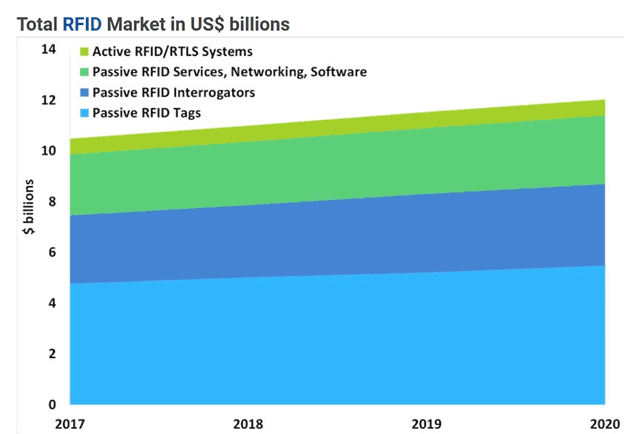The global RFID market for RFID is expected to be about $11 billion in 2018, according to the latest estimate from the researchers at IDTechEx.
Supply Chain Digest Says... |
 |
| IDTechEx only expects the total RFID market by its definition to reach about $12 billion in 2020 versus the $11.5 billion expected this year, indicating growth of just over 2% per year. |
 |
What do you say? |
| Click here to send us your comments |
 |
| Click here to see reader feedback |
|
|
That's up just a little a bit from $10.5 billion or so in 2017. The market definition behind the numbers includes passive tags, passive readers, software and services that go along with RFID implementation, and tags, readers and systems for so-called active tags, which unlike passive tags carry their own power source and are generally used for asset tracking applications (sometimes also referred to as real-time locator systems or RTLS.)
Of the $11 billion total market, passive RFID tags make up $5.01 Billion and passive RFID tag readers will be about $2.85 Billion. The numbers of units sold and their average sales price (ASP) vary across the range of choices. In 2018, IDTechEx expects that 11.5 billion RAIN RFID labels (RFID operating at ~900MHz) will be sold, versus 4.0 billion HF tags (RFID operating at 13.56MHz).
The RAIN type RFID tags are the ones used in most retail, apparel and other supply chain applications. High frequency tags, on the other hand, are primarily used in applications that involve payments, secure access and transit. The HF tag average sale price is much higher than RAIN RFID due to the security required in those applications. In 2018, 2.15 Billion contactless cards will be sold, with growth coming from contactless payment cards in addition to contactless transit cards.
Passports are another big market for HF RFID.
IDTechEx says that in 2018 use of RAIN RFID on apparel will reach about 8 billion tags or 10% of the total addressable market (TAM) of tagging retail apparel - estimated to be 80 billion units this year. That seems like a high percentage to SCDigest, but that is the number estimated globally.
By 2023 IDTechEx forecast the number of tagged apparel items will grow to 21 billion units.
The breakdown from IDTechEx of the global market by the four main categories of RFID tags, readers and software and services is shown below.

Source: IDTechEx
(See More Below)
|
CATEGORY SPONSOR: SOFTEON |
|
|
| |
|
|
IDTechEx says particularly strong growth is expected for tagging airline baggage. This year the key airline regulatory body, IATA, announced that it is developing an RFID standard for baggage tagging with the aim of airlines rolling out RFID in 2020. Delta Airlines is already an early mover. The market has a TAM of 3.6 billion tags a year.
Outside the retail-apparel sector, RAIN RFID is deployed across many other industries but only in small volumes for each project. Globally, however, IDTechEx says these add up to increasingly significant volumes. It estimates that 2 billion RAIN RFID tags will be used for asset tracking in 2018 alone across many industries.
The market for RFID could get a bump from a Japanese government ministry that has set a goal of tagging 100 billion retail items by 2025. However, that is based on a 1 yen (less than 1 US cent) tag being available by 2025, "which is too optimistic" IDTechEx says.
Competitive Threats
Interestingly, IDTechEx notes some competitive technology threats to RFID. For example, machine vision has improved to the point where several companies can use inexpensive cameras to identify items or assets at a reasonable distance. The hardware and software technology development is funded by other industries, such as autonomous vehicle sensors to cameras in consumer phones, creating scale for such technologies that those in item identification can potentially reap. Then there is the on-going developments of systems based on Bluetooth Low Energy and the huge associated reader network.
Oddly, the press release from IDTechEx does not mention the healthcare market for RFID, thought to be substantial by many estimates.
IDTechEx only expects the total RFID market by its definition to reach about $12 billion in 2020 versus the $11 billion expected this year, indicating modest growth of 4.45% per year.
Any reaction to these RFID market numbers? Let us know your thoughts at the Feedback section below.
Your Comments/Feedback
|